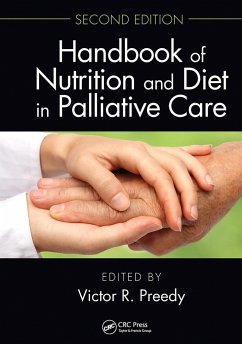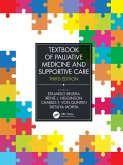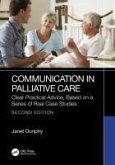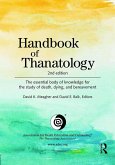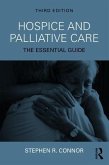Handbook of Nutrition and Diet in Palliative Care, Second Edition, is a comprehensive guide, providing exhaustive information on nutrition and diet in terminal and palliative care. It covers physical, cultural and ethical aspects, bridging the intellectual divide in being suitable for novices and experts alike. Following in the tradition of its predecessor, chapters contain practical methods, techniques, and guidelines along with a section on applications to other areas of palliative care. Each chapter features key facts highlighting important areas, summary points, and ethical issues.
FEATURES
- Use of cannabinoids in palliative nutrition care
- Pain control in palliative care
- Communications in palliative/end-of-life care: aspects of bad news
- Anorexia in cancer: appetite, physiology, and beyond
- Palliative care in severe and enduring eating disorders
- Linking food supplementation and palliative care in HIV
- Eating-related distress in terminally ill cancer patients and their family members
- Palliative care of gastroparesis
- Preoperative nutrition assessment and optimization in the cancer patient
- Childhood leukemia, malnutrition, and mortality as components of palliative care
- End-of-life decisions in persons with neurodevelopmental disorders
- Resources: listing web sites, journals, books and organizations
FEATURES
- Use of cannabinoids in palliative nutrition care
- Pain control in palliative care
- Communications in palliative/end-of-life care: aspects of bad news
- Anorexia in cancer: appetite, physiology, and beyond
- Palliative care in severe and enduring eating disorders
- Linking food supplementation and palliative care in HIV
- Eating-related distress in terminally ill cancer patients and their family members
- Palliative care of gastroparesis
- Preoperative nutrition assessment and optimization in the cancer patient
- Childhood leukemia, malnutrition, and mortality as components of palliative care
- End-of-life decisions in persons with neurodevelopmental disorders
- Resources: listing web sites, journals, books and organizations
'This expanded and reorganized handbook addresses the educational needs of health professionals, family members, and caregivers regarding the value of nutrition in end-of-life care. [...] The handbook covers more than information about nutrition: for example, section 1 ("Setting the Scene") includes separate chapters on the meaning of palliative care, the role of religion and culture at end of life, quality of life, sedation, pain control, and communication. Users' understanding will be enhanced by the chapter summaries reviewing key facts, ethical issues, and important abbreviations. [...] The underrecognized importance of nutrition and sparsity of research make this a valuable resource to bridge the "intellectual divide [between] novices and experts" providing care to the terminally ill.'
Summing Up: Highly recommended. All readers.
-- L. K. Strodtman, emerita, University of Michigan, CHOICE Reviews.
'In the preface, Preedy notes that, "Optimal terminal and palliative care requires consideration of the patient and family unit as well as cultural and religious sensitivities...and there is an increasing awareness that diet and nutritional support play an integral part in the patient's holistic well-being."
The book has 35 chapters, presented in six sections, with contributions from 77 experts from around the world. Section I, "Setting the Scene," describes palliative care in its bio-psychosocial context, nutrition and quality of life, refractory cancer cachexia, and the nutritional consequences of sedation in palliative care; whilst I am not certain they belong in a book about nutrition, there are two good chapters providing overviews of pain management and communication issues. Section II includes the cultural aspects of enteral feeding, and provides East Indian and Italian perspectives on nutrition in palliative care. Section III covers artificial nutrition and hydration, dysphagia, and anorexia. Section IV covers nutritional assessments, appetite and nausea, vitamin deficiency, and eating-related distress. Section V is about nutritional considerations in non-cancer palliative care patients, including those with HIV; there is a detailed chapter on the use of cannabinoids in palliative nutrition care. The last section includes an impressive list of resources for further information on diet and nutrition in palliative care.
The book is well set out with a liberal use of headings and a list of contents at the beginning of each chapter, making the information accessible. Each chapter ends with a list of key points, followed by a summary in bullet-point form that seems well referenced.
This is a book on nutrition in terminal and palliative care that considers the physical, cultural, and ethical aspects. If you work in palliative care, referring to this volume may help with difficult and complex problems, as well as provide factual information on topics - such as the medicinal use of cannabinoids - as part of palliative nutritional care.
Professor Victor Preedy is a senior staff member of the Diabetes and Nutritional Sciences Research Division of the Faculty of Life Science and Medicine at King's College, London.
-- Roger Woodruff, July 2019
Description: This is a compendium of the unique nutrition needs in palliative care. Comprising a plethora of topics, it covers a lot of ground in concise chapters. Each chapter includes tables, textboxes, and figures to highlight key information. This is a much-needed update, given the original book was published in 2011.
Purpose: The purpose is to address the current lack of nutrition books that focus specifically on terminal and palliative care. There are none that cover the topic with the breadth and depth that this one does.
Audience: The book has a lofty goal of attempting to meet the needs of all readers: doctors, nursing staff, and ancillary staff, including registered dietitians, students, and lecturers. It does seem to meet the needs of healthcare professionals as a whole, and it can certainly be used for higher level registered dietitians and residents.
Features: Each of the 35 chapters is written by a different international healthcare professional. The chapters cover every topic that I could think of that is important to know in palliative care: deficiencies, supporting hydration at end of life, pain control and use of cannabinoids, just to name a few. Chapters begin with a table of contents and an introduction. They include key facts, which could be definitions of words found in the chapter or main conclusions in the topic area. They end with summary points and references. The last two chapters include a case study and an extensive listing of resources for palliative care. I was particularly interested in the summary points. I found it a great way to gain better insights into each chapter and then go back to find the key information I was looking for based on the summary. While I really liked the comprehensive list of resources, organizations, journals, books, and other online sources in the last chapter, I do see that becoming outdated very quickly.
Assessment: For healthcare professionals involved in palliative care, this book is a must read. Since it has been eight years since the original edition, this is a much-needed update.
-- Amy Hess Hess Fischl, MS RDN LDN BC-ADM CDE (University of Chicago Medical Center), Doody's Review Service
Summing Up: Highly recommended. All readers.
-- L. K. Strodtman, emerita, University of Michigan, CHOICE Reviews.
'In the preface, Preedy notes that, "Optimal terminal and palliative care requires consideration of the patient and family unit as well as cultural and religious sensitivities...and there is an increasing awareness that diet and nutritional support play an integral part in the patient's holistic well-being."
The book has 35 chapters, presented in six sections, with contributions from 77 experts from around the world. Section I, "Setting the Scene," describes palliative care in its bio-psychosocial context, nutrition and quality of life, refractory cancer cachexia, and the nutritional consequences of sedation in palliative care; whilst I am not certain they belong in a book about nutrition, there are two good chapters providing overviews of pain management and communication issues. Section II includes the cultural aspects of enteral feeding, and provides East Indian and Italian perspectives on nutrition in palliative care. Section III covers artificial nutrition and hydration, dysphagia, and anorexia. Section IV covers nutritional assessments, appetite and nausea, vitamin deficiency, and eating-related distress. Section V is about nutritional considerations in non-cancer palliative care patients, including those with HIV; there is a detailed chapter on the use of cannabinoids in palliative nutrition care. The last section includes an impressive list of resources for further information on diet and nutrition in palliative care.
The book is well set out with a liberal use of headings and a list of contents at the beginning of each chapter, making the information accessible. Each chapter ends with a list of key points, followed by a summary in bullet-point form that seems well referenced.
This is a book on nutrition in terminal and palliative care that considers the physical, cultural, and ethical aspects. If you work in palliative care, referring to this volume may help with difficult and complex problems, as well as provide factual information on topics - such as the medicinal use of cannabinoids - as part of palliative nutritional care.
Professor Victor Preedy is a senior staff member of the Diabetes and Nutritional Sciences Research Division of the Faculty of Life Science and Medicine at King's College, London.
-- Roger Woodruff, July 2019
Description: This is a compendium of the unique nutrition needs in palliative care. Comprising a plethora of topics, it covers a lot of ground in concise chapters. Each chapter includes tables, textboxes, and figures to highlight key information. This is a much-needed update, given the original book was published in 2011.
Purpose: The purpose is to address the current lack of nutrition books that focus specifically on terminal and palliative care. There are none that cover the topic with the breadth and depth that this one does.
Audience: The book has a lofty goal of attempting to meet the needs of all readers: doctors, nursing staff, and ancillary staff, including registered dietitians, students, and lecturers. It does seem to meet the needs of healthcare professionals as a whole, and it can certainly be used for higher level registered dietitians and residents.
Features: Each of the 35 chapters is written by a different international healthcare professional. The chapters cover every topic that I could think of that is important to know in palliative care: deficiencies, supporting hydration at end of life, pain control and use of cannabinoids, just to name a few. Chapters begin with a table of contents and an introduction. They include key facts, which could be definitions of words found in the chapter or main conclusions in the topic area. They end with summary points and references. The last two chapters include a case study and an extensive listing of resources for palliative care. I was particularly interested in the summary points. I found it a great way to gain better insights into each chapter and then go back to find the key information I was looking for based on the summary. While I really liked the comprehensive list of resources, organizations, journals, books, and other online sources in the last chapter, I do see that becoming outdated very quickly.
Assessment: For healthcare professionals involved in palliative care, this book is a must read. Since it has been eight years since the original edition, this is a much-needed update.
-- Amy Hess Hess Fischl, MS RDN LDN BC-ADM CDE (University of Chicago Medical Center), Doody's Review Service

